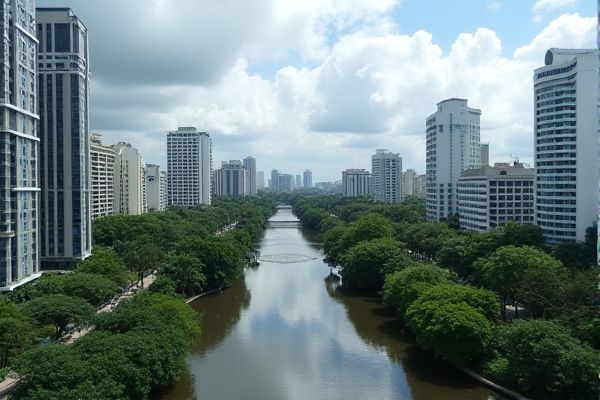
Weather and climate in Indonesia: Tropical climate dominates. High humidity levels year-round. Consistent daytime temperatures. Two main seasons: dry and wet. Dry season: April to October. Wet season: November to March. Rainfall varies by region. Monsoon winds affect weather. Coastal areas more humid. Mountain regions cooler.
Tropical climate dominates.
Indonesia's climate is almost entirely tropical, characterized by uniform warm temperatures with coastal plains averaging 28°C, inland areas at 26°C, and higher mountain regions at 23°C. The country experiences two main seasons: a dry season from April to October and a wet season from November to March, with significant regional variations in rainfall. For more detailed information, you can visit the official website of Indonesia Travel to explore the intricate details of Indonesia's weather patterns and what travelers can expect during different times of the year.
High humidity levels year-round.
Indonesia experiences high humidity levels year-round, typically around 75% even during the dry season, with humidity often exceeding 80% in the wet season, particularly in regions like Bali. These climatic conditions are persistent and can be quite intense, impacting both daily activities and comfort levels for residents and visitors alike. For more detailed insights into these environmental dynamics, as well as practical advice for expatriates, check out the Expat Guide to Indonesia on Aetna International. Understanding the climate is crucial for adapting to life in this vibrant and culturally rich nation.
Consistent daytime temperatures.
In Indonesia, daytime temperatures are consistently warm, with coastal plains averaging around 28°C (82°F), inland and mountain areas averaging 26°C (79°F), and higher mountain regions averaging 23°C (73°F). The variation from season to season is minimal, and the Climate of Indonesia predominantly remains stable throughout the year, largely due to its equatorial location.
Two main seasons: dry and wet.
Indonesia has two main seasons: the dry season, which lasts from April to October, and the wet season, which runs from November to March. The climate is tropical, with little variation in temperature but significant differences in rainfall between the two seasons. For more detailed information about Indonesia's climate, visit the official Indonesia Travel website.
Dry season: April to October.
The dry season in Indonesia, particularly in areas like Java and Bali, typically spans from April to October, characterized by relatively dry and sunny conditions, making it ideal for outdoor activities, cultural exploration, and beach activities. For more detailed information about Indonesia's climate, visit the General Information on Climate page.
Wet season: November to March.
In Indonesia, the wet season typically runs from November to March, characterized by heavy rainfall, high humidity, and frequent showers, with regional variations in precipitation intensity, particularly more significant in western and northern parts of the country. For more information about Indonesia's climate, you can visit the official website of Indonesia Travel and explore their detailed descriptions.
Rainfall varies by region.
In Indonesia, rainfall varies significantly by region, with western and northern parts, such as Western Sumatra, Java, and the interiors of Kalimantan and Papua, experiencing the most precipitation, often exceeding 2,000 millimeters per year, while areas closer to Australia, like Nusa Tenggara, are relatively dry. For more detailed information on this topic, you can visit the Climate of Indonesia page.
Monsoon winds affect weather.
Indonesia's weather and climate are significantly influenced by Monsoon Winds, with the northeast monsoon bringing heavy rains from October to April and the southwest monsoon causing a dry season from April to October. Each monsoon affects different regions and impacts rainfall patterns across the archipelago. For more detailed information, you can visit the overview on the Weather and Climate in Indonesia page to understand how these seasonal changes shape the diverse climatic conditions of the nation.
Coastal areas more humid.
In Indonesia, coastal areas are characterized by high humidity, with averages of 80% or more during the wet season, and temperatures ranging from 72°F to 90°F, making the climate hot and humid year-round. For more detailed information, you can visit the Weather in Indonesia section on Intrepid Travel's website, which offers comprehensive insights into the climatic conditions across various regions. This consistent weather pattern supports a diverse range of flora and fauna, making Indonesia a unique and vibrant destination for travelers. Whether exploring the lush jungles, pristine beaches, or volcanic landscapes, staying informed about the local weather can enhance any travel experience.
Mountain regions cooler.
In Indonesia's mountainous regions, the highland climate zone prevails, characterized by cooler temperatures due to higher elevations, with distinct seasonal variations and diverse ecosystems such as montane forests, grasslands, and alpine meadows. These areas, found in Sumatra, Java, Sulawesi, and Papua, experience temperatures that drop with increasing elevation, supporting unique flora and fauna adapted to cooler conditions. For more detailed information on these [different climate regions of Indonesia](https://www.earth-site.co.uk/Education/climate-zones-of-indonesia-different-climate-regions-of-indonesia/), you can explore resources that detail these fascinating variations in climate and biodiversity.
